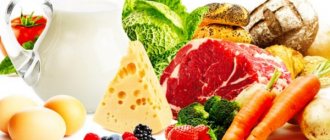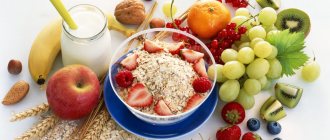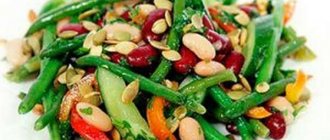Carbohydrates[edit | edit code]
Yuzhakov Anton Carbohydrates
Carbohydrates
- the main source of energy for the body. They are necessary for the normal functioning of muscles, the central nervous system, heart, liver; play an important role in the regulation of protein and fat metabolism. With sufficient intake of carbohydrates into the body, the consumption of proteins and fats is limited, and vice versa.
Carbohydrates in food products are divided into simple and complex:
- Simple carbohydrates include mono- and disaccharides (sugars). They have a sweet taste, easily dissolve in water, are highly digestible and are used to form glycogen.
- Among complex carbohydrates, starch occupies the main place.
It is an essential nutrient in plant foods (especially grains and legumes, as well as potatoes). Starch contained in foods is digested relatively slowly; Thanks to this, the glucose to be absorbed is formed gradually, which creates favorable conditions for its possible complete use. Simple sugars are quickly absorbed into the blood and, if in excess, can be excreted in the urine.
Athletes' daily carbohydrate needs
is 9-10 g per 1 kg of body weight; with 64% coming from complex carbohydrates and 36% from simple carbohydrates.
There is still a misconception among some athletes that consuming significant amounts of sugar improves performance. When a large amount of sugar is simultaneously introduced into the body, its level in the blood rises sharply; as a result, it is excreted in the urine, which has a very negative effect on the functioning of some organs. Athletes should consume sugar primarily to sweeten foods and in a variety of sweet dishes. Sometimes you can use the ability of sugar to be quickly absorbed into the blood. So, after a strenuous workout, in order to quickly restore strength, it is recommended to take 50-100 g of sugar.
It should be remembered that under certain conditions in the body, carbohydrates can be converted into fats, which are stored in the body. Therefore, athletes who are prone to obesity should not overuse flour products, sweets and other easily digestible carbohydrates.
A very useful product for athletes, containing easily digestible carbohydrates, is honey. The fructose it contains is good nutrition for the heart muscle, so it is recommended to consume honey after intense training and competitions. Honey should generally be taken at night; At the same time, the sugar content in the diet is correspondingly reduced.
Polysaccharides include cellulose (fiber), which is part of plant cells. Fiber is not absorbed by the body and therefore is not a source of energy, but it is important for the normal functioning of the digestive organs (strengthens intestinal motility, promotes normal bowel movements). If there is not enough fiber in food, digestive disorders and constipation may occur. A large amount of fiber is found in legumes, beets, cabbage, carrots, radishes, prunes, as well as wholemeal bread.
More apples, less bread
The Ministry of Health has established new recommended consumption standards for basic foods. The department's order is at the disposal of Rossiyskaya Gazeta.
You should not go heavy on baked goods - about 260 grams per day and on potatoes - no more than 250 grams. Pisces are advised to eat more. But the standard is only 60 grams per day. The Ministry of Health recommends eating eggs about five times a week. In the document, all these standards are given per year.
For comparison, six years ago, a middle-aged Russian who was not engaged in heavy physical labor was “prescribed” 95-105 kilograms of bread products per year. Currently, no more than 96 kilograms is recommended. It was also recommended that Russians consume 95-100 kilograms of potatoes per year. Now this figure has been reduced to 90 kilograms. For meat, the recommended standards remained at the same level. It was 70-75 kilograms per year. Now - 73. The Ministry of Health recommends eating most poultry meat - chickens, turkeys, ducks, geese - up to 31 kilograms per year. Then comes beef - 20 kilograms, then pork - 18 kilograms, but it would seem that dietary lamb is advised to consume relatively little - up to 3 kilograms per year.
For vegetables, the current recommendations have moved towards the upper limit from the previous ones - up to 140 kilograms per year, the same with fruits and berries - up to 100 kilograms. Most of all, the Ministry of Health believes, you need to eat apples - 50 kilograms.
“The recommendations to reduce the presence of bread and potatoes, as well as sugar in the diet, are absolutely correct,” Leonid Kholod, former head of the department for development of the agro-industrial complex of the Russian government, Doctor of Economic Sciences, shared his opinion in an interview with Rossiyskaya Gazeta. — Russians eat a lot of these products, which is not very good for health. Another thing is that they make such a choice not based on taste or other gastronomic preferences, but based on their ability to pay. Fish, vegetables and fruits are not a cheap pleasure for many categories of citizens.”
It’s ambiguous with dairy products: the previous norm was within the range of 320-340 kilograms per year, the current one is clearly 325 kilograms. “It seems that the new standards were established to bring them into line with actual production,” says Leonid Kholod.
Order on approval of recommendations on rational standards for consumption of food products that meet modern requirements for a healthy diet
Daily carbohydrate intake in an athlete's diet[edit | edit code]
An important step in optimizing a training diet is to ensure that the athlete is consuming adequate amounts of carbohydrates, proteins and fats.
People following a general fitness program need approximately the same amount of nutrients as the average person (i.e. 45-55% carbohydrates, 3-5 g/kg/day; 10-15% fat, 0.8-1 .0 g/kg/day; and 25-35% proteins, 0.5-1.5 g/kg/day).
With large and medium volumes of training, athletes should include more carbohydrates and proteins in their diet. For example, athletes who engage in moderate amounts of intense training (2-3 hours per day of intense exercise 5-6 times per week) typically need a dietary carbohydrate content of 55-65% (5-8 g/kg/day or 250-1200 g/day for athletes weighing 50-150 kg), in order to maintain adequate glycogen levels in the liver and muscles.[1][2]
Research has also shown that athletes with high intensity training volume (3-6 hours per day for 1-2 workouts per day, 5-6 days per week) need 8-10 g/day/kg carbohydrates (400-1500 g/ day for athletes weighing 50-150 kg) to maintain adequate muscle glycogen levels.[1][2]
This is equivalent to eating approximately 0.5-2.0 kg of spaghetti. Preference should be given to complex carbohydrates with a low to medium glycemic index (for example, whole grains, vegetables, fruits, etc.). However, taking this amount of carbohydrates along with regular food can be physically taxing, which is why many experts recommend drinks or other supplements with concentrated carbohydrates (such as weight gainers). Consumption of this amount of carbohydrates is not necessary for regular fitness activities (workouts 3-4 times a week for 30-60 minutes), but is necessary for large and medium volumes of intense training.
Currently, there is an opinion in the scientific literature that the human body is capable of oxidizing up to 1-1.1 grams of carbohydrates per minute, or about 60 grams per hour.[3]
The American College of Sports Medicine (ACSM) recommends 0.7 g/kg/hour during exercise as a 6-8% solution (6-8 grams of carbohydrate per 100 ml of fluid). With this approach, carbohydrate consumption per hour will be 30-70 grams for an athlete weighing 50-100 kg.[4][5][6] Research has also shown that eating more carbohydrates does not increase the amount of carbohydrates the body has time to oxidize. It has also been noted that the rate of oxidation may vary depending on the type of carbohydrates consumed, as they are carried by different transporters.[7][8][9] For example, the rate of oxidation of disaccharides and polysaccharides such as sucrose, maltose and maltodextrins is high, while fructose, galactose, trehalose and isomaltulose are, on the contrary, low.[10][11]
The combined intake of glucose and sucrose, or maltodextrin and fructose, promotes the highest rate of oxidation among all carbohydrate intakes studied.[7][8][9][10][11][12][13][14][15]
These studies used a ratio of 1-1.2 maltodextrin to 0.8-1.0 fructose. For this reason, we recommend paying attention to the type of carbohydrates you consume before, during, and after workouts to increase their availability in the body.
Read more:
How many carbohydrates do you need per day?
Balanced diet: food standards
Recommendations on proper nutrition are often vague: the call to eat “more vegetables” and “less sugar” causes confusion for many, because if for one “a lot of sugar” means two teaspoons, then for another the syrup is “sour.” When planning your diet, you should proceed from your needs and preferences, and as a more specific guideline, you can rely on objective daily and weekly food standards calculated for an average-weight adult.
Meat: 170 g per day
The daily norm for an adult of average weight and age is 170 g of meat per day, which includes both red meat and poultry. It is highly desirable that half of this norm be poultry, in which case the intake of cholesterol into the body will be optimal. The fact that this norm is daily does not mean that you should definitely eat this amount of meat every day: you can eat it, for example, 4 times a week - 250 g.
Fish: 300 g per week
The optimal regimen for eating fish is 3 times a week, 100 g each, or 2 times a week, 150 g each. Since fatty fish (salmon, trout, tuna, mackerel, herring, etc.) contain very healthy omega-3 fatty acids acids, nutritionists recommend including the consumption of these types of fish in the specified norm. Also included in the norm are all seafood - shrimp, mussels, squid, etc. Try to eat a varied diet!
Vegetables: 300-400 g per day
This norm is a minimum of vegetables per day; if you eat more, it will only be for the better. The principle of diversity in relation to vegetables is realized in the fact that it is very desirable to include both cooked (stewed, boiled, fried, in soups) vegetables and fresh, raw (in salads) in the daily diet. Make sure that this norm is not completely covered by starchy, hearty vegetables (potatoes, beans, beans, peas).
Fruits: 200-300 g per day
As in the case of vegetables, the indicated amount of fruit is the minimum; It's good if you eat even more fruit. Besides, 200-300g is just a large apple, a couple of peaches or a full cup of berries, which is not that much. When we talk about fruits, we mean fresh fruits, since fruits made from jam or compotes no longer have an impressive range of beneficial properties. But fresh and recently prepared fruits also count (peaches in pies, scalded pears in fruit salad, or oven-baked apples).
Cereals: 6-8 servings per day
Grain products include all cereals, as well as bread and pasta. It is highly advisable to consume as many whole grains (unprocessed grains) as possible. To get an idea of the portions, it is worth considering that one serving of grains is half a cup of ready-made porridge or pasta, a slice of bread 50-75 g. That is, the daily norm of 8 servings is a large plate of porridge, pasta (up to 4 cups of ready-made food) or 350-450 g of bread. It will be healthier for the body if you eat all types of grains - but little by little: for example, 200 g of bread + a small plate of porridge.
Bread: 200-250 g per day
Despite the fact that bread belongs to grain products, it should be placed in a separate group, since this is exactly how people themselves perceive it - separately, as an independent product - when they consume it. The norm of 200-250 g should include all bread - both white and black, and it is highly desirable that there is a place in this list for whole grain bread (with bran). With a balanced diet, the daily norm will look something like this: one small white bun (80-100 g) and 100 g of black grain bread.
Fats: 1-1.3 g/kg per day
The daily fat intake is 1-1.3 g per kg of your weight per day. That is, if you weigh 80 kg, your norm is 80-90 g of fat. Important: this norm includes all fat consumed per day, including from ready-made meals. Therefore, when calculating the amount of fat consumed in its pure form (vegetable oil, butter), you must keep in mind that this is not the only fat you consumed. You also need to ensure that the daily diet contains both animal and vegetable fat, and the share of unsaturated fats (vegetable) is at least 50% of the total.
Sugar: 9 (6) teaspoons per day
The norm for sugar consumption is 9 teaspoons (for men) and 6 teaspoons (for women) per day. The norm includes not only visible sugar (what you, for example, put in tea, added when baking a pie, or consumed as candy), but also hidden sugar - sugar from dishes. Sugar is present in an overwhelming number of dishes (yogurt, baked goods, bread, cereals, cottage cheese products, sweets, dried fruits, etc.), so if you are not going to count every grain of sugar in your diet, try to cut your sugar intake by 2- 3 times. Having consumed 2-3 spoons of sugar, you will know that you got the rest with ready-made dishes.
Salt: 5 g per day
The daily salt requirement is 1 teaspoon (5 g). The norm includes both “live” salt in your soup or salad, and hidden salt in marinades, herring, chips, bread, sausage, etc.
Coffee: 300 mg caffeine per day
The appropriate volume of coffee itself depends on the powder used, on the concentration, strength and type of coffee, but on average 300 mg of caffeine is contained in 300-400 ml of ready-made moderate-strength coffee brewed from natural powder, or in 500-600 ml of a drink made from instant coffee. coffee.
Alcohol: 30 (20 for women) ml ethanol per day
When we talk about alcohol, we do not mean the “norm”, but the permissible dose of alcohol - the amount that does not cause serious harm to the body.
The permissible dose is 20 ml of ethanol per day for women, 30 ml of ethanol per day for men. To calculate the volume of an alcoholic drink, it is enough to know the ethanol concentration and the strength of the drink. So, if you drink 10% wine, then the permissible dose will be 200 ml (average glass) of wine for a woman and 300 ml for a man. alcohol food diet meat fish salt sugar fruit vegetables bread
Abuse of carbohydrates[edit | edit code]
Frequent and high consumption of carbohydrates, as studies show, has a negative effect on the sensitivity of insulin receptors, leading to increased insulin levels. Chronic elevation of insulin due to frequent consumption of carbohydrates throughout the day can increase insulin resistance towards the end of the day. Reducing your carbohydrate intake, as well as alternating between low-carb days and moderate-carb days, can help stabilize insulin levels and promote effective fat loss. Read: diet for weight loss.
Sources[edit | edit code]
- ↑ 1.01.1 Leutholtz B, Kreider R: Exercise and Sport Nutrition. In Nutritional Health. Edited by Wilson T, Temple N. Totowa, NJ: Humana Press; 2001:207-39.
- ↑ 2,02,1 Sherman WM, Jacobs KA, Leenders N: Carbohydrate metabolism during endurance exercise. In Overtraining in Sport. Edited by Kreider RB, Fry AC, O'Toole ML. Champaign: Human Kinetics Publishers; 1998:289-308.
- Kerksick C, Harvey T, Stout J, Campbell B, Wilborn C, Kreider R, Kalman D, Ziegenfuss T, Lopez H, Landis J, Ivy JL, Antonio J: International Society of Sports Nutrition position stand: nutrient timing. J Int Soc Sports Nutr 2008, 5:17.
- Rodriguez NR, Di Marco NM, Langley S: American College of Sports Medicine position stand. Nutrition and athletic performance. Med Sci Sports Exerc 2009, 41(3):709-31.
- Rodriguez NR, DiMarco NM, Langley S: Position of the American Dietetic Association, Dietitians of Canada, and the American College of Sports Medicine: Nutrition and athletic performance. J Am Diet Assoc 2009, 109(3):509-27.
- Sawka MN, Burke LM, Eichner ER, Maughan RJ, Montain SJ, Stachenfeld NS: American College of Sports Medicine position stand. Exercise and fluid replacement. Med Sci Sports Exerc 2007, 39(2):377-90.
- ↑ 7.07.1 Currell K, Jeukendrup AE: Superior endurance performance with ingestion of multiple transportable carbohydrates. Med Sci Sports Exerc 2008, 40(2):275-81.
- ↑ 8,08,1 Jeukendrup AE, Moseley L: Multiple transportable carbohydrates enhance gastric emptying and fluid delivery. Scand J Med Sci Sports 2008.
- ↑ 9,09,1 Earnest CP, Lancaster SL, Rasmussen CJ, Kerksick CM, Lucia A, Greenwood MC, Almada AL, Cowan PA, Kreider RB: Low vs. high glycemic index carbohydrate gel ingestion during simulated 64-km cycling time trial performance. J Strength Cond Res 2004, 18(3):466-72.
- ↑ 10,010,1 Venables MC, Brouns F, Jeukendrup AE: Oxidation of maltose and trehalose during prolonged moderate-intensity exercise. Med Sci Sports Exerc 2008, 40(9):1653-9.
- ↑ 11,011,1 Jentjens RL, Jeukendrup AE: Effects of pre-exercise ingestion of trehalose, galactose and glucose on subsequent metabolism and cycling performance. Eur J Appl Physiol 2003, 88(4-5):459-65.
- Achten J, Jentjens RL, Brouns F, Jeukendrup AE: Exogenous oxidation of isomaltulose is lower than that of sucrose during exercise in men. J Nutr 2007, 137(5):1143-8.
- Jentjens RL, Venables MC, Jeukendrup AE: Oxidation of exogenous glucose, sucrose, and maltose during prolonged cycling exercise. J Appl Physiol 2004, 96(4):1285-91.
- Jeukendrup AE, Jentjens R: Oxidation of carbohydrate feedings during prolonged exercise: current thoughts, guidelines and directions for future research. Sports Med 2000, 29(6):407-24.
- Rowlands DS, Wallis GA, Shaw C, Jentjens RL, Jeukendrup AE: Glucose polymer molecular weight does not affect exogenous carbohydrate oxidation. Med Sci Sports Exerc 2005, 37(9):1510-6.










